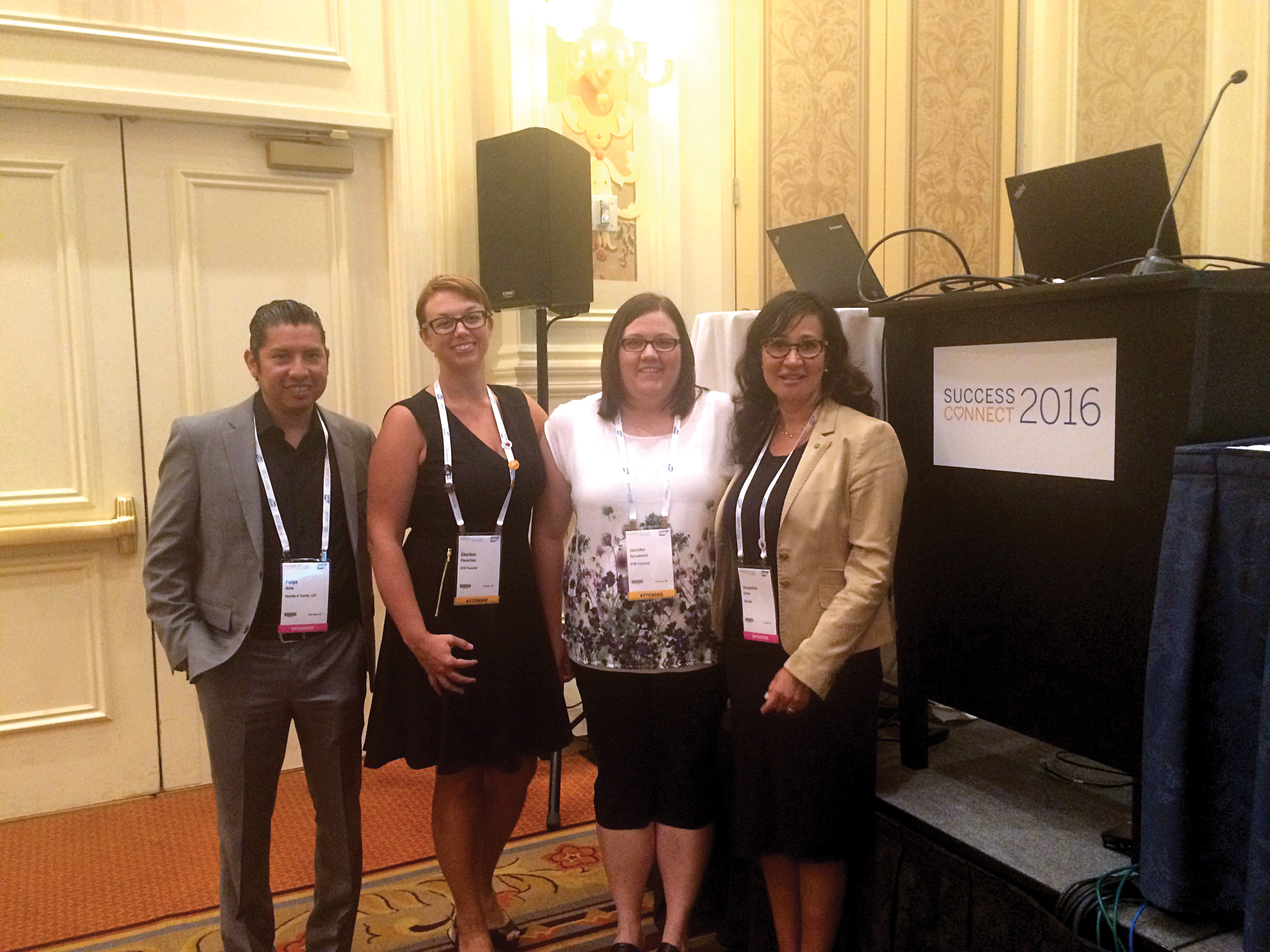ATB Financial, a financial services Crown corporation in Edmonton, Alberta, with nearly 750,000 customers throughout Canada’s fourth-largest province, prides itself on being an exceptional place to work. A Work 2.0 initiative holds its roughly 5,000 employees — referred to as team members — accountable for results, not the number of hours logged at their desks. In its “Everyday Heroes” recognition program, employees recognize contributions from other employees. These recognitions can earn them points that can then be redeemed for everything from hot tubs to playoff hockey tickets. Recognitions exceed 100,000 per year and are posted on a community newsfeed.
“One of our strategic goals is making ATB the place to bank and the place to work,” says Charleen Pomerleau, Senior Leader of ATB’s P&C Operations team, which stands for People and Culture. “Everything that we do is for our customers and team members; a people-first philosophy is a strong part of our heritage.”
This philosophy extends to ATB’s information technology (IT) systems. A desire for employees to have more transparency and self-service capabilities with a centralized, fully automated human resources (HR) solution was one of the main drivers for ATB to move off its legacy system, which relied extensively on manual entry of HR transactions and interactions through a central employee service center. A general lack of visibility into these manual processes did not encourage ATB team members to feel as though they were stakeholders in their own success. “The focus of P&C Operations is on the team member experience, and part of that is to make sure that all our HR applications are smart, simple, helpful, and in alignment with ATB’s strategy of being known as a great place to work,” says Pomerleau.
As an affirmation of this strategy, ATB’s transition to a new HR system would involve more than adding new functionality. Rather, the organization opted to view the change as an opportunity to transform HR to better reflect the importance it places on team members taking ownership of their career paths and overall success.
Cloud Gains Interest
Shortly after ATB implemented a greenfield instance of SAP ERP 6.0 to run its finance and customer-facing operations, the HR department began its search for a solution to serve as the centerpiece of a new HR platform. While added transparency was perhaps the top requirement, another priority was avoiding the need for a lot of customization. The heavily customized legacy system had become increasingly difficult for HR to maintain over the years as the department attempted to design processes to adhere to ATB’s employee-first philosophy. Fewer customization needs would also allow for greater flexibility for future growth.
With this requirement, a cloud-based solution became the front-runner in ATB’s search, as did SAP software — in no small part because the institution had recently implemented SAP ERP. After looking at solutions from several vendors, ATB decided that SAP SuccessFactors solutions best met its requirements and delivered the most robust functionality in a software-as-a-service (SaaS) suite of applications. In 2014, ATB signed a contract with SAP to deliver a wide range of SAP SuccessFactors solutions for core HR, talent, social collaboration, and analytics functionality: SAP SuccessFactors Employee Central, SAP SuccessFactors Employee Central Payroll, SAP Jam, SAP SuccessFactors Learning Management System, and SAP SuccessFactors Workforce Analytics.
“We looked at many different options during the selection process,” says Jennifer Spraakman, Payroll Systems Analyst at ATB. “Because it made strategic sense for us to pick an SAP product, we did consider the on-premise solution. However, the agility and transparency the cloud offered tilted the decision to the SAP SuccessFactors solutions.”
A Mutual Partnership
ATB partnered with Deloitte Consulting to help with the HR process redesign that would make the implementation a transformation project rather than just a technology refresh. Deloitte spearheaded an iterative, agile implementation by kicking off a three-month process redesign in the beginning of 2015. ATB entered the redesign phase with a blank slate by not carrying over any documented processes from its legacy system. Instead, by leveraging Deloitte’s leading practices and a pre-configured template, ATB avoided customizations and largely went into the build phase with industry-leading, out-of-the-box functionality. Finding this approach successful, ATB — which had contracted with Deloitte for only the redesign phase — extended the contract to keep Deloitte on as systems integrator. (For more information about Deloitte’s integral role in the project, refer to the sidebar at the end of the article.)
One of the main selling points for ATB of SAP SuccessFactors Employee Central was how the solution would provide visibility into the company’s entire workforce, while also serving as the core HR system of record. While ATB’s legacy system enabled it to manage transactions, albeit with a reliance on manual tasks, SAP SuccessFactors Employee Central would enable ATB to manage processes. Because it combines personnel data with operational data from outside sources and other SAP SuccessFactors solutions, the solution provides a holistic picture of ATB’s workforce, thus facilitating its ability to define and track HR strategies.
In ATB’s esteem, SAP SuccessFactors Employee Central was the core HR platform that best aligned with its philosophy of putting team members first. The integration of SAP SuccessFactors Employee Central with other SAP SuccessFactors solutions would provide all employees, not just managers, with tools to gauge development. This build strategy was by intent so that team members would be far more likely to feel vested in their success.
“Every team member at ATB uses SAP SuccessFactors solutions in some way, shape, or form,” says Pomerleau. “They can go into what we call ‘myPath’ and view their personal and employment information, and see their job title, salary, certifications, performance reviews, and anything having to do with their employment. This ability is something team members didn’t have in the past.”
Beyond that, SAP SuccessFactors Employee Central is the hub from which managers and HR business partners can make transactions such as onboarding, terminations, transfers, bonuses, workflows, and workflow approvals. Seamless integration with SAP SuccessFactors Employee Central Payroll helps significantly drive down administrative tasks that, in ATB’s previous environment, were part and parcel of meeting payroll.
“In our previous environment, all HR transactions up to and including running payroll were done in one system, and there wasn’t much transparency for team members,” explains Pomerleau. “Team leaders had to fill out a form for most any transaction — hire, transfer, and so forth — and send an email or a spreadsheet and hope it got processed. One of the bigger benefits of the new platform is that this uncertainty goes away. Team leaders can make changes quickly without any extra steps, red tape, or paper. Making the administrative HR work easier allows team leaders more time to focus on business strategy and strengthening ATB’s position as the place to work.”
A Trusted Advisor
At the outset of the project, ATB had been opposed to a big-bang rollout in part to avoid devoting the necessary testing resources to such an approach. However, with the build phase winding down as the last pay period for 2014 fast approached, ATB ended up having to perform a simultaneous rollout. By doing this, it did not have to carry over year-to-date values from the legacy system into the new platform, which outweighed the reluctance to allocate additional testing resources.
Having a trusted systems integrator helped allay concerns about whether ATB was on the right implementation path, according to Pomerleau. “With change experts versed in SAP SuccessFactors Employee Central and SAP SuccessFactors Employee Central Payroll rollouts, Deloitte could point to other customers who had a similar experience,” she says. “They always knew what we needed to do next, and if there was ever a question, they would come back with the answer.”
Spraakman credits Deloitte’s experience as an implementation partner with helping ATB avoid scope creep and keep customizations at bay. “They advised against certain requests if they might delay the implementation timeline,” she says. “As a result, we are running payroll virtually as-is, right out of the box.”
Meeting with and learning from a number of other SAP SuccessFactors customers was one of the more pleasant surprises of the entire project for the team. Being able to compare notes and share ideas with other companies not only helped to fine-tune the new HR platform, it also squared nicely with ATB’s stated mission of being a people-first organization.
“We were introduced to a great community of SAP SuccessFactors customers, each with their own experience,” Pomerleau says. “Having a community like this is something we weren’t used to having with our legacy system.”











